Cat carrier training means teaching your cat to use a pet carrier without becoming stressed and anxious. You can use a cat carrier to take your cat to the vet clinic, when you’re traveling with your feline friend, and in an emergency when you need to get to safety quickly.
Cat carriers have plenty of benefits, including safer transport for your pet, easier vet and groomer visits, stress reduction, and hassle-free evacuation during an emergency. Once your cat is familiar with her carrier, getting her inside is relatively straightforward; you only need to tempt your cat with treats or a favorite toy. However, if your cat resists, simply approach from behind, wrap her in a blanket, and quickly put her into the carrier.
Crucially, you’ll learn how to get your cat into the carrier safely in our step-by-step guide, and there are plenty of helpful tips for successful cat carrier training.
So, what are you waiting for? Keep reading to learn everything you need to know about hassle-free cat carrier training!
What Are The Benefits Of Cat Carrier Training?
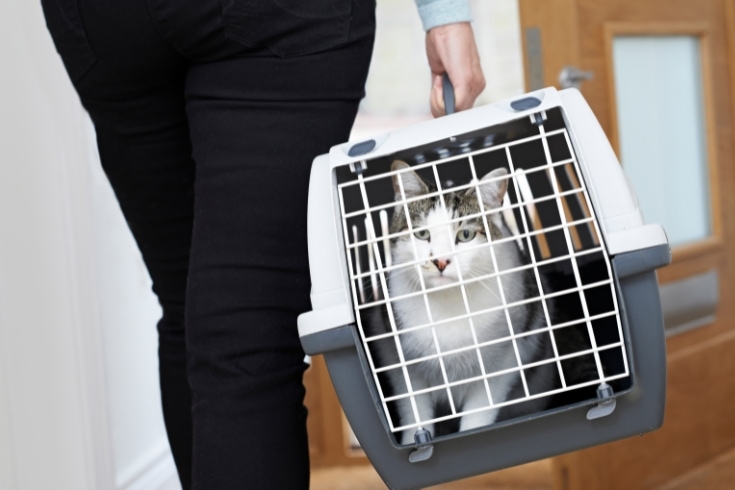
The benefits of cat carrier training include reducing stress in a nervous cat, making visits to your vet clinic easier, safer travel for you and your pet, easier evacuation in an emergency situation, easier grooming, and other behavioral benefits.
So, you can see just how important cat carrier training is for you and your furry friend!
Stress Reduction
Cats often associate a trip in a pet carrier with something unpleasant, such as a trip to the vet clinic for vaccinations or when sick. However, research shows that cat carrier training helps reduce the fear and stress that your feline friend feels when presented with the carrier.
Easier Vet Visits
As mentioned above, if your cat associates her carrier with a vet visit, she won’t be keen to enter her carrier. That can leave you faced with your cat making like a starfish when you try to put her into her carrier, leaving you frustrated and your cat stressed out.
If you take the time to train your cat to associate her carrier with pleasant things, such as treats and praise, vet visits will become much less of a hassle for you and a whole lot less scary for your pet.
Safe Travel
A loose cat in a moving vehicle becomes a potentially lethal projectile if you have a crash or have to brake hard. Riding in a properly secured, high-quality pet carrier is the safest mode of transport for you and your precious pet.
In addition, if you train your cat to walk on a harness and leash, you can break long journeys and give both of you a chance to stretch your legs.
Emergency Situations
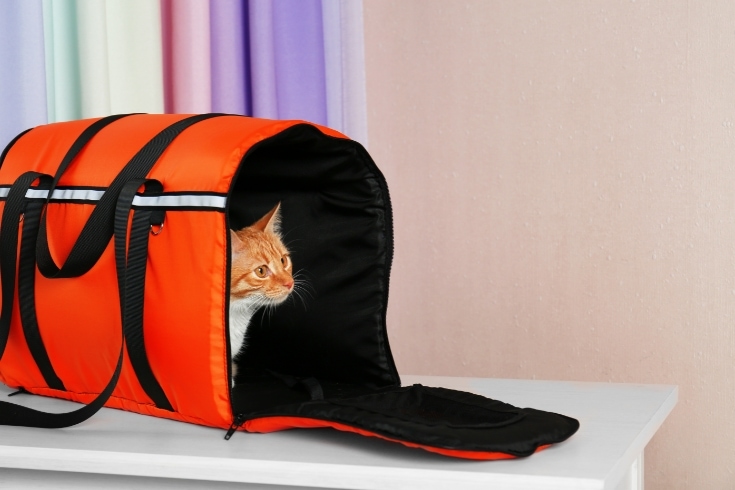
If you live in a region that’s prone to natural disasters, such as tornados, having a cat that’s happy to enter and stay in her carrier makes evacuation and taking temporary shelter much safer and easier.
Easier Grooming
If you own a long-haired breed of cat, you might need to take her to the grooming salon every so often to have a professional do the job for you. Transporting your cat to the groomer in a carrier is the safest and easiest way to get there.
However, cats can be injured if they’re reluctant to exit their crate via the front door, so using a top-loading carrier is best for the groomer and your cat. Simply lifting your pet out of the carrier from above prevents her from getting stuck and avoids accidental scratching injuries to you and your groomer.
Behavioral Benefits
As well as the above benefits, using a carrier in a multi-cat household at feeding times can help prevent food guarding and aggression by giving each cat its own space, reducing conflict and competition.
If you have a cat that hasn’t been well-socialized with strangers and other animals, it can be helpful to use a carrier to introduce your furry friend to new experiences in a controlled way.
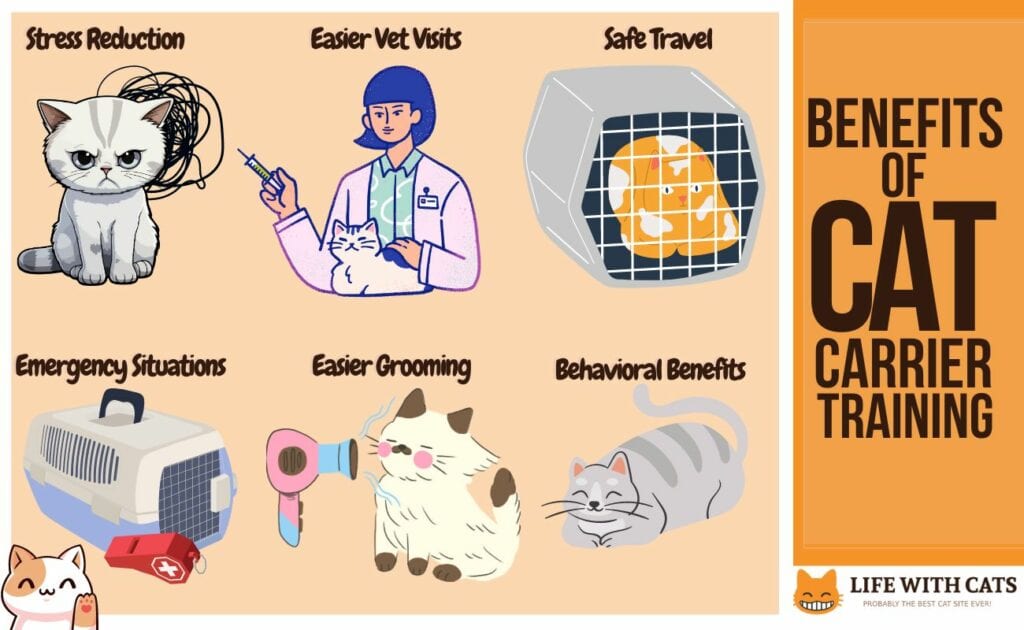
Why Do Cats Fear Carriers?
The reason cats fear carriers are often related to past experiences or their natural instincts. Here are a few common reasons your cat might fear her carrier.
- Cats are creatures of routine and habit and can feel uncertain when faced with a new or unfamiliar situation or object, such as a cat carrier.
- Rescue or shelter cats often associate a pet carrier with a vet visit or some other unpleasant, stressful past experience.
- Cats are independent animals; many hate feeling trapped or confined inside a box or carrier, which can cause fear and anxiety.
- Cat carriers are generally made from plastic or fabric that can have quite a strong smell, which is overpowering and unpleasant to a cat’s keen senses.
How Do I Choose The Right Cat Carrier?
Choosing the right cat carrier is crucial for your pet’s comfort, safety, and confidence.
I always use this top-opening cat carrier to transport my large feline friend because I find it much easier to remove the cat from the carrier and load him into it without either of us risking injury. The best cat carrier for a young cat is probably not the same as an adult cat carrier, so you’ll probably need to upsize as your cat grows.
Size Considerations
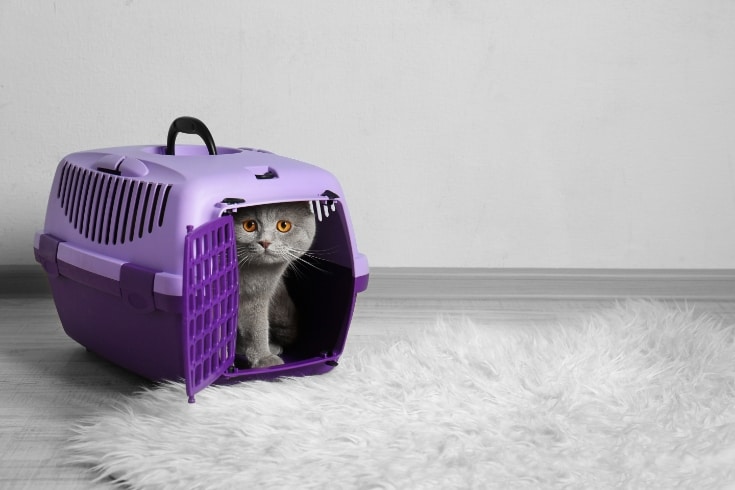
The carrier should be roughly one and a half times the size of your cat and large enough for her to stand, sit, and turn around comfortably.
If the carrier is too small, your cat will feel cramped and uncomfortable, which could make her resentful of her carrier. On the other hand, a carrier that’s too big leaves your pet sliding around or even rolling over in the carrier during transit, with the same result that she won’t want to use it in the future.
Material And Durability
Cat carriers come in a range of materials and colors, some with zipper fastenings and others with secure plastic buckles. Larger cat carriers tend to be made from rigid plastic, whereas small ones are usually fabric. You can also buy wire mesh-style pet carriers and sturdy cardboard ones.
Whatever style of carrier you choose, you want one that’s strong, durable, escape-proof, and can withstand a fidgeting cat.
It’s essential that your chosen carrier has excellent ventilation, especially if you plan to take long journeys with your cat. Most fabric carriers incorporate plenty of mesh into their design, ensuring good airflow so your cat doesn’t overheat, while plastic carriers usually feature slatted sides and a metal mesh front door.
Ease Of Cleaning
Accidents do happen, so you want to choose a cat carrier that’s easy to clean. I always line my carriers with a washable blanket or bed and place a puppy training pad underneath to catch any liquid.
What Do You Need For Cat Carrier Training?
The things you need for cat carrier training are a good-quality carrier, some training treats, a comfy bed, and plenty of time and patience to invest in training your cat. You can use a clicker training device if you want to, and pheromone calming aids can be helpful to help settle a nervous cat.
Cat Carrier
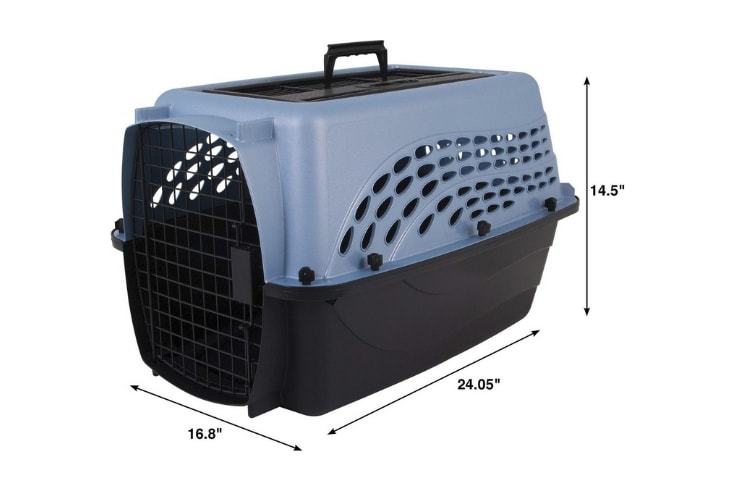
The first essential item you’ll need is a cat carrier.
As mentioned earlier, there’s a huge range of carriers to choose from, and the style you go for is largely a matter of personal choice. I prefer a robust plastic carrier for my large cat, but I also have a fabric, holdall style carrier for my smaller girl.
Treats

You’ll need a selection of treats to reward your cat during the cat carrier training process. Be sure to choose your cat’s favorite edible treats!
Comfortable Bedding
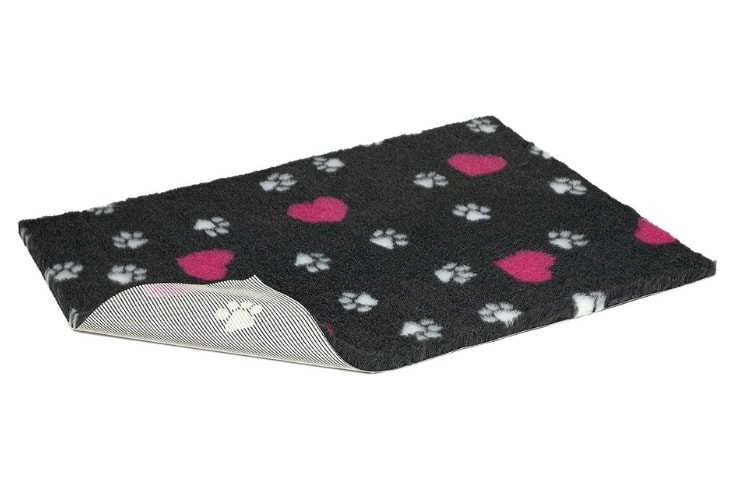
The cat carrier should be a comfortable, cozy place where your cat enjoys resting, so you’ll need a bed or crate mat. If you opt for a plastic carrier, check that the bed or mat fits properly and doesn’t slide around under the cat during transit.
I always use Vetbed to line my carriers. It has a non-slip base, is super warm and cozy, and you can pop it into your washing machine to freshen it up when necessary. This stuff is great value, too – mine is still going strong after 10 years plus of daily use and has survived multiple washes!
Feliway Or Calming Aids (Optional)

If you have a nervous cat that hates the idea of being confined in her carrier, you might want to try using a product such as Feliway or another pheromone calming aid.
These products are totally safe and can be highly effective in helping your cat to chill out in her carrier. Calmers are typically available in spray or plug-in form, so you can choose whichever option suits your cat best.
Clicker (Optional)
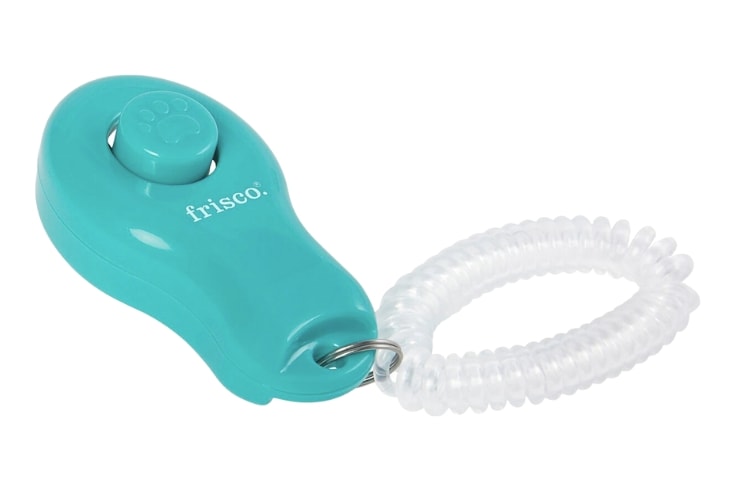
Some cat owners find clicker training to be a very effective method of positive reinforcement training, so you’ll need a clicker device if you want to take this route.
Patience And Time
Training your cat to spend time in her carrier takes a lot of patience and time; it’s not something you can hope to achieve overnight!
In my experience, kittens and young cats are more likely to use a cat carrier without objection relatively quickly than older cats that might have had a bad experience in the past. So, teaching your cat to enjoy her carrier can take from days to months, depending on the individual cat.
How Do You Get A Cat Into A Carrier?
To get a cat into a carrier, you’ll need to prepare the carrier to make it as appealing as possible to your pet. The key to cat carrier training is to teach your cat to associate her carrier with positive experiences while providing your pet with reassurance and lots of rewards.
When working on how to get a cat into a carrier, always use positive reinforcement training methods and allow plenty of time.
Prepare The Carrier
Prepare the cat carrier by ensuring it’s clean and free from dust and dirt. Add a comfortable, washable bed or blanket to keep your cat warm and dozy, perhaps with a puppy training pad underneath in case of accidents.
If you’ve chosen to use a calming product, you might want to spray the bedding with it or a plug-in unit in your chosen training area.
Familiarize Your Cat With The Carrier
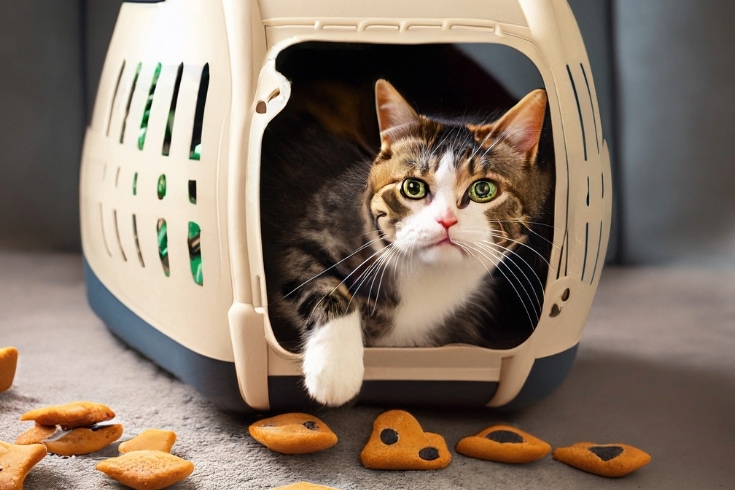
Now, you need to familiarize your cat with her carrier.
When my cats were kittens, I placed my carrier in an area close to their food bowls and scattered a few treats and toys inside to tempt the babies. Curiosity took over, and both kitties soon happily explored the carrier, gobbling up the treats and playing with the toys!
Associate Carrier With Positive Experiences
You can try using the same technique that worked for my kittens to teach your cat that her carrier is safe to visit and a cool place to spend her time.
Leave the carrier open in a spot where your cat spends much of her time. Add treats to the carrier daily, and try feeding your cat close to it. I’ve even had several cats in the past that have readily used the carrier as a bed when they want somewhere peaceful, dark, and quiet to relax!
Use A Towel Or Blanket
When you need your cat to go into the carrier, for example, on the day of a trip to the vet, place a blanket or familiar-smelling towel inside the carrier to provide familiarity and comfort for your cat.
Approach From Behind
The easiest way to pick up your cat is to approach her from behind, ideally from a kneeling position. Avoid towering over the cat and leaning over her if possible, as that could frighten your pet and even trigger her into running away from you.
If you have a top-loading cat carrier or one with a removable lid, gently lower your cat into the carrier through the top, ensuring you support her body and provide her with plenty of reassurance.
Guide The Cat Into The Carrier
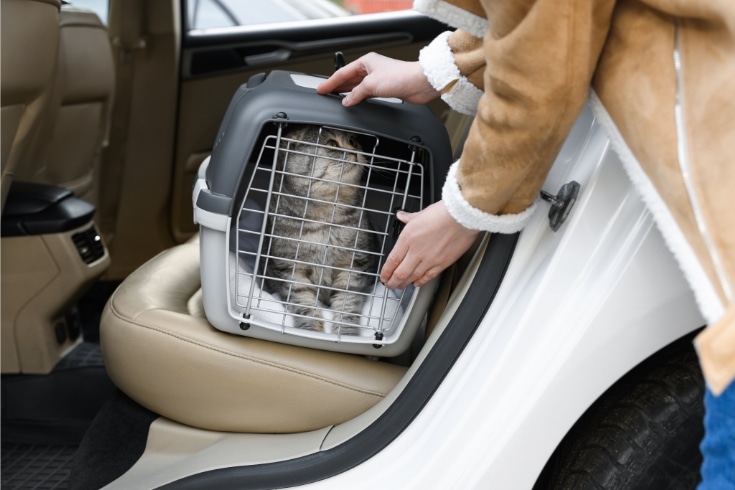
Hopefully, if your familiarization training has gone well and the cat has accepted the carrier, you’ll be able to gently guide her into the carrier by using her favorite treats or even a toy.
Don’t force the cat into the carrier, as that will stress her and create a negative association with the carrier, potentially causing problems in the future.
Secure The Carrier
Before lifting the cat carrier, double-check that you’ve secured all the fastenings so the door or top-loading hatch doesn’t come open accidentally.
Zip fastenings should have a locking feature to prevent handy kitty cats from pawing them open, so be sure to check they are securely fastened.
Provide Reassurance And Rewards
Throughout the cat carrier training process and when loading your cat into her carrier, keep reassuring her and giving her plenty of fuss and treats so that she learns to associate going into the carrier with good things.
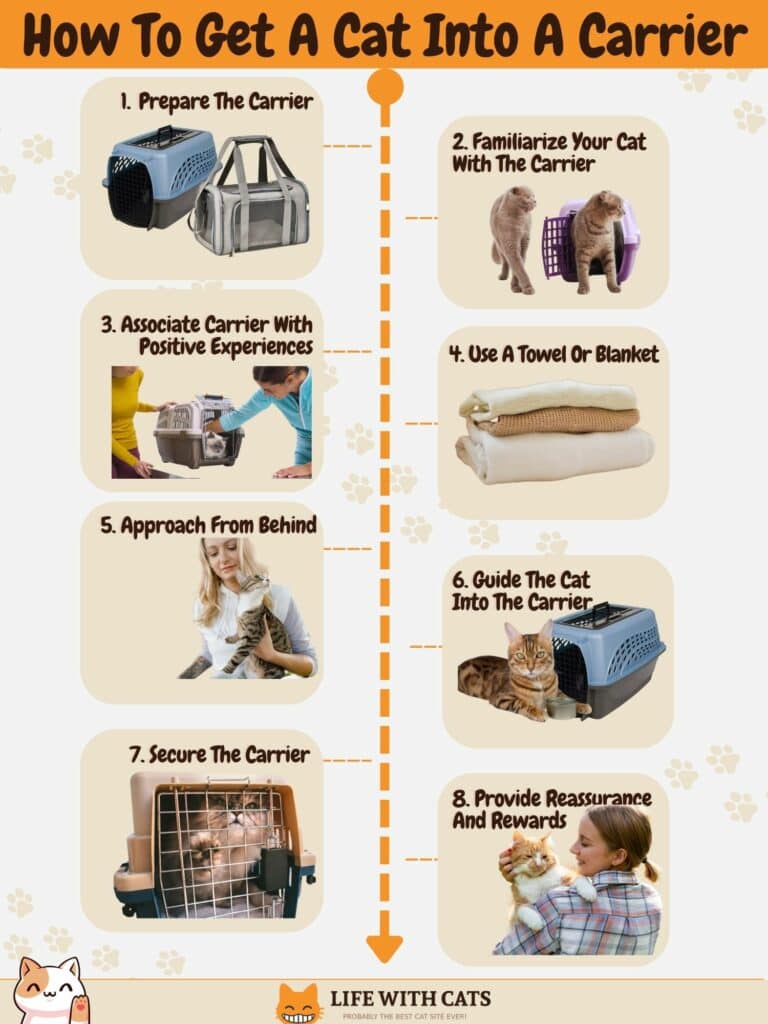
What Are Tips For Successful Cat Carrier Training?
The tips for successful cat carrier training are to be patient, use positive reinforcement, keep the sessions short and fun for your cat, and gradually increase the length of time your cat spends confined to the carrier.
If your cat becomes aggressive, distressed, or extremely resistant to being placed in the carrier, I strongly recommend you seek professional advice from your vet or a professional animal behaviorist.
Patience, Consistency, And Positive Reinforcement
Throughout your cat carrier training, you must be patient, especially if your cat is reluctant or afraid. Be consistent in your approach, and always use positive reinforcement, including praise, treats, and cuddles.

Make Training Sessions Short And Enjoyable
Cats typically have a short attention span, so be sure to keep your training sessions brief and enjoyable by including lots of different activities and breaking off for play sessions, too.
Gradually Increasing The Duration Of Confinement In The Carrier
As your training sessions progress and your cat becomes more confident, increase the duration of her confinement in the carrier. So, to begin with, you might only shut your cat in her carrier for a few minutes, gradually extending that time to five minutes, then ten minutes, until the cat will sit in the carrier without complaining for longer periods.
Seek Professional Guidance If Encountering Significant Challenges
Hopefully, your cat carrier training will go well. However, if you encounter significant challenges, your cat becomes aggressive or extremely distressed when you try to put her in the carrier, always seek professional guidance from your vet or an animal behaviorist.
Cat Carrier Training FAQs
Here are the answers to some commonly and frequently asked questions about cat carrier training.
What Can I Use Instead Of A Cat Carrier?
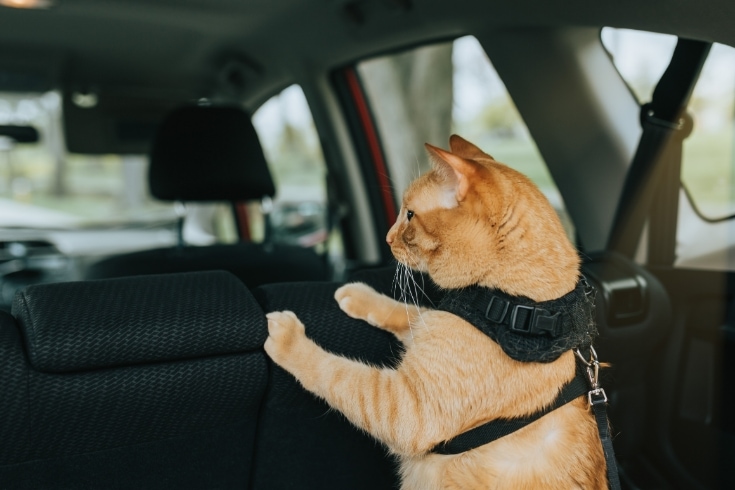
If you don’t have a cat carrier and you need to transport your cat urgently, there are a few alternatives.
- Cats that are harness and leash-trained can travel in cars with the harness securely attached to a seatbelt.
- A well-ventilated sports bag with a flat base lined with a blanket can suffice as a temporary cat carrier, provided you don’t have far to travel.
- A sturdy cardboard box can be used to transport a cat, provided you ensure there’s plenty of ventilation for your pet.
- If you have a small cat or kitten, an old purse can sometimes be repurposed as a cat carrier. Again, remember to make plenty of ventilation holes for your cat.
- Two laundry baskets can be securely fastened together with wire or strong thread to create a makeshift cat carrier. Laundry baskets are typically designed with plenty of air holes in the sides, which double as ventilation for your cat.
Why Do Cats Hate Car Rides?
Cats hate car rides because they are creatures of habit and feel safe and secure in their home environment. When they are taken out of their home, they can feel anxious and stressed by the unfamiliar sights, sounds, and smells of a car.
Here are some other reasons why cats hate car rides:
- Cats only generally ride in cars when taking trips to the vet, which isn’t a fun experience for them!
- Cats don’t enjoy sudden changes in their routine and environment, which you’ll know if you’ve ever moved house and taken a cat with you.
- Some cats suffer from motion sickness.
- Cats dislike loud sounds, strange smells, and unfamiliar sensations, and your car is full of all of those!
How Long Does It Take To Train A Cat For Carrier Travel?
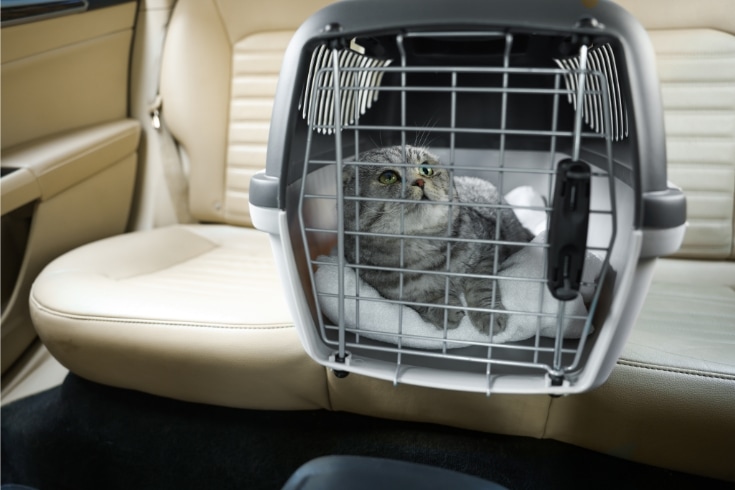
That all depends on your cat! Some cats are less stressy than others and accept traveling in a cat carrier without fuss, whereas others become distressed and anxious the moment the carrier appears.
So, you could be looking at a few days, a couple of weeks, or even months to train your cat for carrier travel; it really depends on the individual animal.
What Are The Best Techniques For Successful Cat Carrier Training?
The best techniques for successful cat carrier training are familiarization, positive reinforcement, patience, and consistency.
Familiarization involves getting the cat used to being around her carrier without actually going inside it. You might want to put the carrier in the room where your cat eats her meals, for example.
Throughout cat carrier training, give your cat lots of praise and treats to show her that spending time in her carrier can be associated with pleasant things. Finally, be consistent in your training so that your cat understands she will be rewarded with a treat and praise whenever she does what you want.
Are There Any Specific Carrier Types Recommended For Cat Training?
Cat carriers with a top opening are generally much easier to use since you can gently lower your cat into the carrier from above. However, front-loading designs with the option to remove the entire top section make it easier to train your cat to like the cat carrier.
How Can I Make The Carrier A More Comfortable And Inviting Space For My Cat?
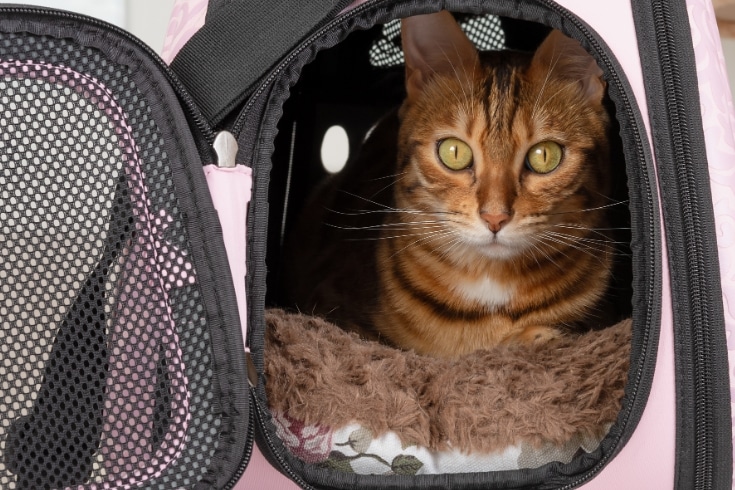
Your first requirement is a cat carrier that is large enough to comfortably accommodate your cat without being so large that she slides around and can’t keep her balance during a journey.
I always use a washable Vetbed blanket inside the carrier on top of a puppy training pad in case of toileting issues en route. In addition, a familiar towel or blanket draped over the top of the carrier can help to calm an anxious cat.
If you have a nervous cat, you could spray the inside of the cat’s carrier with a pheromone spray to help calm it. Use the spray 15 minutes before the cat is due to travel, and use it sparingly.
How Can I Handle A Cat That Is Resistant Or Fearful Of Entering The Carrier?
Before you are ready to travel, calmly approach the cat from behind, holding a blanket in both hands. Place the blanket over the cat quickly and in one smooth movement, ensuring you cover her whole body and head.
Gently but firmly, place your hands over the blanket on the cat’s shoulders, and scoop up your pet, folding the blanket underneath her as you do. Lower the cat directly into the cat carrier immediately, and cover the carrier with a large towel to keep her calm.
What Do I Do If Training Doesn’t Work?
If cat carrier training doesn’t work and you find it is making your cat even more anxious and upset about the prospect of going into her carrier, you should seek the advice of a vet or professional animal behaviorist.
Conclusion
Cat carrier training refers to the process of teaching a cat to use a pet carrier without becoming upset or anxious. Cat carriers are useful when taking your cat to the vet, when traveling with your furry friend, and in the event of an emergency if you need to evacuate your home.
Unfortunately, many cats hate the idea of being confined, so you’ll need to spend time and patience on training your cat to love, not loathe, her carrier. Cat carrier training requires patience, positive reinforcement, and short, fun sessions until your cat will travel happily.
If you find you’re struggling to persuade your kitty to enter the carrier or she becomes agitated or aggressive, always seek professional guidance from a vet or qualified animal behaviorist.